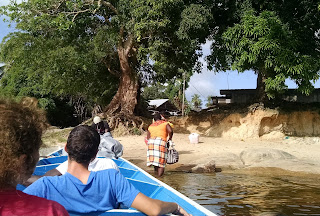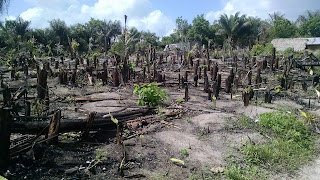At anchor, St. Martin
 |
| Maroons doing dishes and bathing in the river. |
In 17th and 18th century Suriname, the English and Dutch imported slaves from Africa to work on their plantations. Not surprisingly, many slaves tried to escape their horrible fates. The escaped slaves, called Maroons, evaded capture by living deep in the jungle or up the river beyond the plantations. There they set up communities and lived like they had in Africa. Their descendants still live in those jungle villages today.
 |
| Dugouts at Atjoni are the only link to many of the villages upriver. |
We've seen in our travels elsewhere some very poor people, some at a subsistence level. But most everywhere, the basic structure of their lives has been a simpler and poorer version of what we are used to in the US. Maybe someone's tiny shack has no electricity. Or perhaps there are many living in one room and they have few belongings. Life in the Maroon villages is very different.
 |
| This is the "big city" among the Maroon villages of Nieuw Aurora |
For most Maroons, life is centered on the Suriname river. Getting from place to place happens via the river. The river
is where they wash their dishes. It's where they wash their clothes. It's where they wash themselves and it's where they get their drinking water. As we traveled the river we saw all of this.
Boats, under motor, paddle, or oar were always coming and going along the water.
Few docks exist here, so peole just offload supplies and people alongside a large rock or tree or by wading.
Women and girls stood knee-deep at the shore, bending over to wash dishes. Others stood near exposed rocks, washing clothes by scrubbing them against rocks or drying them by beating them on the rocks. Men, women, and children lathered up to bathe.
Clusters of Maroon homes are arranged in a haphazard fashion, some communities with just a few huts and others containing dozens. These tiny homes are built in a traditional way with the exception of using sawn (vs hand-hewn) planks, Most have thatched rooves, but some have corrugated tin rooves. A few have foundations of beach-made bricks which were created using sand from the river. A few have modern doors or windows, but most use only cloth to cover windows and doors, or nothing at all. Almost all are tiny with just a single room.
 Each home is actually a compound of three huts. One is built as the main living and sleeping space. A second is the kitchen, where food is prepared and assembled and where pots and dishes are stored hanging on the walls. The third hut is for cooking, which is done over an open fire or in a clay oven.
Each home is actually a compound of three huts. One is built as the main living and sleeping space. A second is the kitchen, where food is prepared and assembled and where pots and dishes are stored hanging on the walls. The third hut is for cooking, which is done over an open fire or in a clay oven.A woman's status depends strongly on the cleanliness of her kitchen and the number of pots, pans, and other items. Clean and shiny pots and pans are extremely important, and the smoke resulting from cooking over an open fire would soot thing up, so the separate building for cooking is necessary to keep the pots and pans shiny. Women load each meal's dishes into a wheelbarrow or a large basket carried on the head and walk them to the river for washing.
Top: outdoor cooking arrangement to the left, broom to the right.
Bottom: To the left is a very very nice house. Both left and right are
unleavened bread made from cassava root, drying in the sun
(on the roof and on a log).
Bottom: To the left is a very very nice house. Both left and right are
unleavened bread made from cassava root, drying in the sun
(on the roof and on a log).
 |
(Shown here are mangos). |
 |
| The dark blue piece is the marriage cloth. |
Not surprisingly, responsibility for raising the children is with women. It is a child's uncle, however, who is financially responsible for a child's wedding and dowry. Some children attend school, but not all do. Maroons speak one of five dialects of the local "bush language," which is somewhat akin to the Creole language of Sranan. Suriname schools though are taught in Dutch, so Maroon children enter school with the disadvantage of needing to learn a second language.

Men are responsible for hunting and fishing, and they eat just about any kind of creature including possums, lizards, and monkeys. Unfortunately, much of the wildlife has been depleted in the areas near these communities. Some men travel to Paramaribo to work, and return after a few months with money for the family. Men build the homes and the dugout canoe boats used to navigate the river.
Villagers are largely isolated, though that is made less so with the advent of cell towers in the area. Some villagers have cell phones, but that hasn't stopped them from continuing to live in such a traditional way.
The Dutch government has funded a museum of Maroon culture that has opened in Pikin Slee. Founded by five young men, it displays their wood-work and shows what life is like in the village.

The Sraanan Museum entrance.
| 
Four of the five museum founders.
|
 |
| The owner of the only store in Pikin Slee (considered quite big) was happy to have us take his picture. |
Efforts by the government or others to "improve" their lives are largely rejected by the Maroons. Installation of a platform containing multiple plastic cisterns for rain-water collection has been left broken and unused. A recently-erected Catholic church was burned down. These humble people seem determined to continue a traditional way of life that is largely gone from the rest of the world.
























Post a Comment